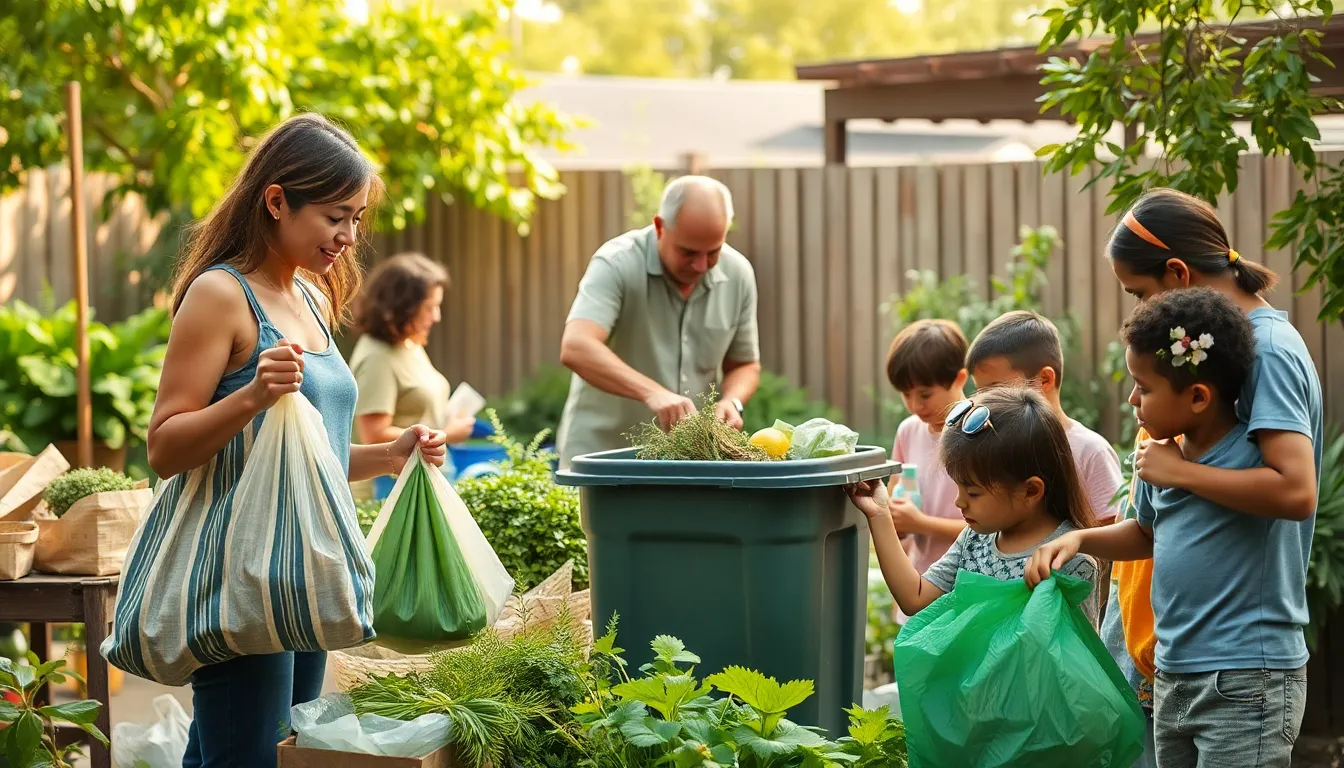Table of Contents
ToggleIn a world where plastic straws seem to have more social media followers than some celebrities, sustainable living has become the new cool kid on the block. It’s not just about hugging trees or wearing hemp sandals—though those are great too. Sustainable living is about making choices that protect our planet for future generations while still enjoying life’s little pleasures.
What Is Sustainable Living?
Sustainable living encompasses lifestyle choices that promote environmental health. It involves using resources in a way that reduces harm to the planet. This lifestyle seeks to balance ecological conservation with daily activities.
Sustainable living includes practices such as reducing waste and conserving energy. He or she may choose to use energy-efficient appliances or opt for public transportation. Individuals often seek local and organic food sources to minimize carbon footprints.
Water conservation plays a critical role in this lifestyle. Collecting rainwater or installing low-flow fixtures contributes to water savings. It’s essential to recognize the impact of everyday actions on ongoing environmental issues.
Sustainable living also emphasizes reducing dependence on single-use plastics. Many individuals are opting for reusable bags, bottles, and containers. This shift not only lessens waste but also promotes a circular economy.
Participating in community initiatives strengthens the impact of sustainable living. Joining local clean-up efforts or community gardens fosters a sense of belonging. Collaboration enhances knowledge sharing and encourages eco-friendly practices among peers.
Choosing sustainable materials for home and clothing can significantly lower one’s environmental footprint. Selecting bamboo, hemp, or recycled fabrics stands as a smart alternative. This approach highlights the importance of supporting brands committed to eco-friendly practices.
Sustainable living isn’t just about personal choices. It’s a collective movement that influences policies and encourages companies to adopt greener practices. Advocating for sustainable policies ensures a healthier planet for future generations.
Key Principles of Sustainable Living

Sustainable living comprises several key principles that support environmental health while enhancing quality of life. These principles guide individuals towards more eco-friendly choices.
Reduce, Reuse, and Recycle
Reducing waste remains foundational in sustainable living. Individuals limit consumption and minimize their environmental impact by prioritizing durable products over single-use items. Reusing materials, such as containers and bags, extends the life cycle of products. Recycling programs further support this effort, diverting waste from landfills and repurposing materials into new products. Communities that emphasize these practices foster a sense of responsibility and collective action toward sustainability.
Conservation of Resources
Conservation of resources plays an essential role in sustainable living. Individuals optimize energy use by adopting energy-efficient appliances and utilizing natural light. Water-saving fixtures and mindful practices, such as shorter showers, significantly reduce water waste. Choosing locally sourced and seasonal foods conserves resources needed for transportation and storage, while also supporting local economies. Preservation of natural habitats and ecosystems ensures that resources remain available for future generations.
Benefits of Sustainable Living
Sustainable living offers numerous advantages for individuals and the planet. The core benefits revolve around environmental preservation and economic savings.
Environmental Impact
Sustainable practices significantly reduce harmful effects on ecosystems. By minimizing waste and conserving energy, individuals contribute to a healthier planet. Carbon emissions decline when people choose local and organic foods, which cuts transportation emissions and supports local farmers. Rainwater collection and low-flow fixtures promote efficient water usage, ensuring resources remain available for future generations. Involving communities in local clean-ups and gardens fosters a deeper connection with nature while enhancing collective environmental responsibility. Every step taken toward sustainability reinforces the importance of protecting biodiversity and combating climate changes.
Economic Advantages
Economic benefits also stem from sustainable living choices. Initially, investing in energy-efficient appliances might appear costly, but long-term savings follow from reduced utility bills. Purchasing locally sourced products often supports community economies, creating jobs and stimulating local growth. Durability in sustainable materials leads to fewer replacements, translating into further savings over time. Additionally, individuals who adopt zero-waste practices frequently find reduced spending through reusing items and minimizing reliance on single-use plastics. Overall, embracing sustainable living not only contributes to environmental health but also builds a more resilient financial future.
Challenges in Adopting Sustainable Living
Adopting sustainable living presents several challenges that can hinder individuals and communities. Overcoming these hurdles requires understanding and strategic approaches.
Awareness and Education
Awareness levels about sustainable practices often vary among individuals and communities. Many people lack access to crucial information about sustainable living. Educational initiatives play a key role in raising awareness and guiding effective practices. Local workshops and online resources can significantly improve knowledge on topics like reducing waste and conserving energy. Advocating for sustainability within schools can instill eco-friendly values in younger generations. Knowledge sharing through community groups fosters a collective understanding of sustainability’s importance.
Accessibility and Affordability
Accessibility issues frequently prevent people from adopting sustainable choices. Many sustainable products and services often come with a higher price tag, limiting options for lower-income households. Availability of local organic food and sustainable materials can also vary by region. Urban areas typically offer more access to eco-friendly options compared to rural settings. Financial incentives or subsidies can support transitions to sustainable living by making green products more affordable. Efforts to improve distribution networks for sustainable goods can enhance accessibility and encourage widespread adoption.
Practical Tips for Sustainable Living
Sustainable living involves adopting practices that reduce one’s environmental impact while enhancing quality of life. These actionable tips help individuals make a difference daily.
Energy Efficiency
Maximizing energy efficiency plays a crucial role in sustainable living. Choosing appliances with the ENERGY STAR label reduces electricity consumption significantly. Utilizing LED light bulbs also provides long-lasting alternatives to traditional incandescent bulbs. Incorporating smart home technology, like programmable thermostats, helps optimize energy use. Regular maintenance on heating and cooling systems ensures they run efficiently. Insulating homes properly minimizes the need for heating and cooling, contributing to energy savings.
Sustainable Transportation
Sustainable transportation options greatly lessen carbon footprints. Biking and walking not only provide health benefits but also decrease reliance on motor vehicles. Public transit systems, such as buses and trains, offer eco-friendly commute alternatives. Carpooling reduces the number of vehicles on the road, leading to lower emissions. Electric vehicles present sustainable choices with reduced greenhouse gases when charged with renewable energy. Additionally, choosing to combine errands into fewer trips enhances overall efficiency and resource conservation.
Sustainable living represents a powerful shift toward a healthier planet and a more fulfilling lifestyle. By making conscious choices that prioritize environmental health individuals can enjoy life’s pleasures while minimizing their ecological footprint.
Embracing practices like reducing waste conserving energy and supporting local economies not only benefits the environment but also fosters community connection. While challenges remain in accessibility and affordability education and awareness play crucial roles in overcoming these barriers.
As more people commit to sustainable living the collective impact can drive significant change paving the way for a more resilient future for generations to come.







